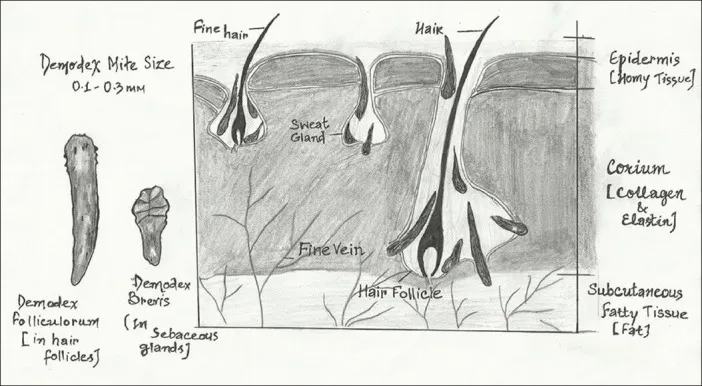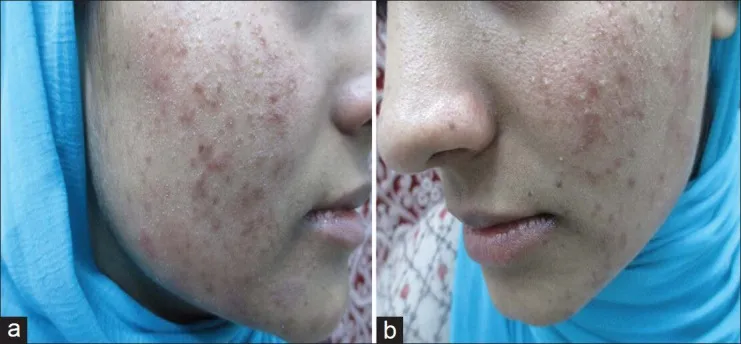The bond we share with our canine companions is special, but sometimes, concerns arise about the tiny inhabitants they might carry. A common question among pet owners is: “Can Dog Mites Live In Human Hair?” The thought of parasites transferring from our beloved pets to us can be unsettling, leading many to seek clarity on this crucial topic. While it’s true that mites are a prevalent concern for both humans and animals, understanding their specific nature, particularly host specificity, is key to alleviating fears and implementing proper preventative measures. This article will delve into the world of mites, differentiating between those found on dogs and humans, and clarify the potential for cross-species transmission, especially regarding human hair.
Parasites are a natural part of the ecosystem, and mites are among the most common. Humans and dogs both host various types of mites, but these tiny arthropods often exhibit a fascinating trait: host specificity. This means that a particular mite species is adapted to thrive on one specific host species, making long-term infestation across different species rare. While some dog mites might temporarily interact with human skin, the idea of them establishing permanent residence in human hair or follicles is generally unfounded. It’s important to differentiate between a temporary irritation and a sustained infestation when discussing such transfers.
Understanding Mites: A General Overview
Mites are minuscule arthropods belonging to the class Arachnida, related to spiders and ticks. They are ubiquitous in various environments, including soil, water, and on living organisms. Many species are parasitic, living on or within a host and feeding on skin cells, oils, or other bodily fluids. Their size, often microscopic, makes them invisible to the naked eye, yet their presence can lead to significant dermatological issues. The concept of host specificity is central to understanding mite transmission; most parasitic mites have evolved to survive and reproduce only on a particular host species, making cross-species infestations uncommon for sustained periods.
Demodex Mites: Human vs. Canine
One of the most frequently discussed types of mites, especially in relation to hair follicles, is Demodex. These microscopic mites reside within or near the pilo-sebaceous units (hair follicles and oil glands) of mammals. While the general appearance and life cycle of Demodex mites share similarities across different hosts, the species themselves are highly host-specific.
Human Demodex: The Usual Suspects
On humans, two primary species of Demodex mites are typically found: Demodex folliculorum and Demodex brevis. These mites are obligatory human ecto-parasites, meaning they are adapted to live on humans. D. folliculorum usually resides in the upper part of hair follicles, often in clusters, while D. brevis burrows deeper into sebaceous glands. They feed on skin cells, hormones, and sebum.
 Microscopic view of a Demodex mite residing within a human hair follicle
Microscopic view of a Demodex mite residing within a human hair follicle
These mites are incredibly common, with studies indicating their presence in a high percentage of healthy adult individuals, often without causing any symptoms. They have an elongated, semi-transparent body with eight short, segmented legs. Their life cycle, from egg to adult, typically spans about 14 days, with adults living for several weeks. Mating occurs near the follicle opening, and eggs are laid within the follicles or sebaceous glands. While generally harmless, an imbalance in the immune system or high densities of these mites can lead to various skin conditions collectively known as demodicosis or demodicidosis.
Canine Demodex: Meet Demodex Canis
Just as humans have their specific Demodex species, dogs host Demodex canis. This mite is an integral part of the normal skin flora of dogs and is specific to canine hosts. Demodex canis resides within the hair follicles of dogs and, like human Demodex, usually coexists harmlessly. However, when a dog’s immune system is compromised, or there’s an overpopulation of these mites, it can lead to a condition called demodicosis, or “demodectic mange.” This can manifest as hair loss, redness, and skin lesions. Understanding the host-specific nature of parasites is crucial, much like knowing how can humans get roundworms from dogs is important for preventing other types of pet-to-human parasite transfers.
Can Dog Mites (Specifically Demodex) Live in Human Hair?
The short answer is generally no, Demodex canis cannot establish a permanent, breeding infestation in human hair or follicles. The host specificity of Demodex mites means that Demodex canis is adapted to the unique environment of a dog’s skin and hair follicles, including specific physiological factors and immune responses that are different from humans. While a Demodex canis mite might temporarily transfer to a human, it cannot survive and reproduce for an extended period. It will not be able to complete its life cycle or establish a thriving colony on a human host.
Therefore, if you have been in close contact with a dog with demodectic mange, it’s highly unlikely that you will “catch” demodectic mites or develop a Demodex infestation similar to what the dog experiences. Any mites that transfer would soon die off without a suitable host environment. This principle of host specificity also applies to other internal parasites, making it reassuring to know that can humans get heart worms from dogs is also highly unlikely, as heartworms are also host-specific.
Beyond Demodex: Other Dog Mites and Human Contact
While Demodex canis is not a threat to human hair, it’s important to consider other types of mites that dogs can carry, as some may cause temporary skin irritation in humans. These are typically not long-term infestations but can lead to uncomfortable symptoms.
Sarcoptic Mites (Scabies Mites)
Perhaps the most common dog mite that can cause human symptoms is Sarcoptes scabiei canis. This mite causes sarcoptic mange (also known as canine scabies) in dogs. Unlike Demodex, these mites burrow into the skin. If a human has close contact with a dog infected with sarcoptic mange, these mites can transfer to human skin. They cannot complete their life cycle or reproduce on humans, as humans have their own host-specific scabies mite (Sarcoptes scabiei hominis). However, the dog scabies mites can burrow into human skin and cause intense itching, red bumps, and a rash—a condition often referred to as “pseudo-scabies” or “canine scabies rash.” These symptoms are usually self-limiting once contact with the infected dog is removed, as the mites eventually die off. Understanding how do humans get roundworms from dogs is another important piece of knowledge for pet owners concerning other zoonotic risks.
Other Mites (Cheyletiella, Otodectes)
Other less common dog mites can also cause transient human irritation. Cheyletiella mites, often called “walking dandruff” due to their appearance and movement, primarily infest dogs, cats, and rabbits. They are visible as tiny white flakes moving on the pet’s fur. If these mites transfer to humans, they can cause itchy, red bumps, but again, they cannot establish a permanent infestation. Otodectes cynotis, or ear mites, are common in dogs and cats, living primarily in the ear canals. While rare, they might occasionally cause temporary itchiness on human skin if direct contact occurs, though this is not their preferred habitat.
Symptoms of Mite Exposure from Dogs on Humans
If you’ve been in contact with a dog carrying mites and experience symptoms, they are typically limited to skin irritation rather than a full-blown infestation in your hair. The symptoms commonly include:
- Intense Itching: This is the most common symptom, often worse at night.
- Red Bumps or Rash: Small, reddish papules or a generalized rash may appear on the skin, particularly on areas that had direct contact with the pet, such as arms, chest, or waist.
- Skin Irritation: The affected areas might feel generally irritated, inflamed, or sensitive.
It’s crucial to note that these symptoms are usually localized and temporary, unlike a true human scabies infestation where mites actively burrow and reproduce. If you are experiencing these symptoms, especially after a dog encounter, consult a healthcare professional for proper diagnosis and guidance. Additionally, awareness of other parasite symptoms in pets can be beneficial, such as knowing the symptoms of roundworms and hookworms in dogs.
 Clinical presentation of rosacea, a skin condition potentially exacerbated by Demodex mites
Clinical presentation of rosacea, a skin condition potentially exacerbated by Demodex mites
Prevention and Management of Mite Transmission
While dog mites generally pose a low risk for establishing a permanent home in human hair, taking preventative measures is always a good idea, especially if your dog has an active mite infestation or if you notice unexplained skin irritation.
- Regular Veterinary Care: Ensure your dog receives routine veterinary check-ups, including screening for parasites. Prompt treatment of any mite infestation in your pet will significantly reduce the chances of transfer.
- Pet Hygiene: Regular bathing and grooming can help keep mite populations under control on your dog. Always use pet-specific shampoos and follow your veterinarian’s recommendations.
- Personal Hygiene: Wash your hands thoroughly with soap and water after petting or handling dogs, especially if you suspect they have a skin condition. Avoid touching your face or hair before washing.
- Environmental Cleaning: Regularly clean and wash your dog’s bedding, blankets, and any areas where they spend a lot of time. This can help eliminate mites that might temporarily fall off the pet into the environment.
- Minimize Contact with Infected Animals: If a dog is known to have an active, transmissible mite infestation (like sarcoptic mange), it’s wise to limit close contact until the dog has been successfully treated.
- Seek Medical Advice: If you develop persistent itching or skin rashes after contact with a dog, consult a doctor. They can determine the cause of your symptoms and recommend appropriate treatment, if necessary. For your dog’s health, it’s also important to understand if my dog has giardia can i get it and take precautions.
 Facial dermatitis with redness and papules, a symptom that can be associated with Demodex proliferation### Treatment Options
Facial dermatitis with redness and papules, a symptom that can be associated with Demodex proliferation### Treatment Options
For humans experiencing temporary skin irritation from dog mites, treatment often focuses on relieving symptoms. Over-the-counter anti-itch creams, antihistamines, or corticosteroids prescribed by a doctor can help manage itching and inflammation. In most cases, once the source of the mites (the infected dog) is treated, human symptoms will resolve on their own as the mites die off. For dogs, veterinary treatment for mite infestations typically involves topical medications, oral medications, or specialized shampoos, depending on the type of mite and severity of the condition.
 Patient exhibiting symptoms of peri-oral dermatitis, one of the diverse manifestations of mite-related skin issues
Patient exhibiting symptoms of peri-oral dermatitis, one of the diverse manifestations of mite-related skin issues
Conclusion
While the question “can dog mites live in human hair” is a valid concern for pet owners, the answer is largely reassuring. Demodex canis, the common follicular mite in dogs, is host-specific and cannot establish a long-term infestation in human hair. However, other dog mites, such as Sarcoptes scabiei canis (causing canine scabies), can cause temporary, itchy skin reactions in humans, though these mites also cannot complete their life cycle on a human host. Understanding the nature of different mites and practicing good hygiene for both pets and humans are the best defenses against any potential transfer. Regular veterinary care for your dog is paramount to keeping them healthy and reducing the risk of any mite-related concerns for your family. If you experience persistent skin irritation, always consult a healthcare professional for accurate diagnosis and advice. Explore more articles on Dog Care Story to ensure your pet leads a happy and healthy life.
